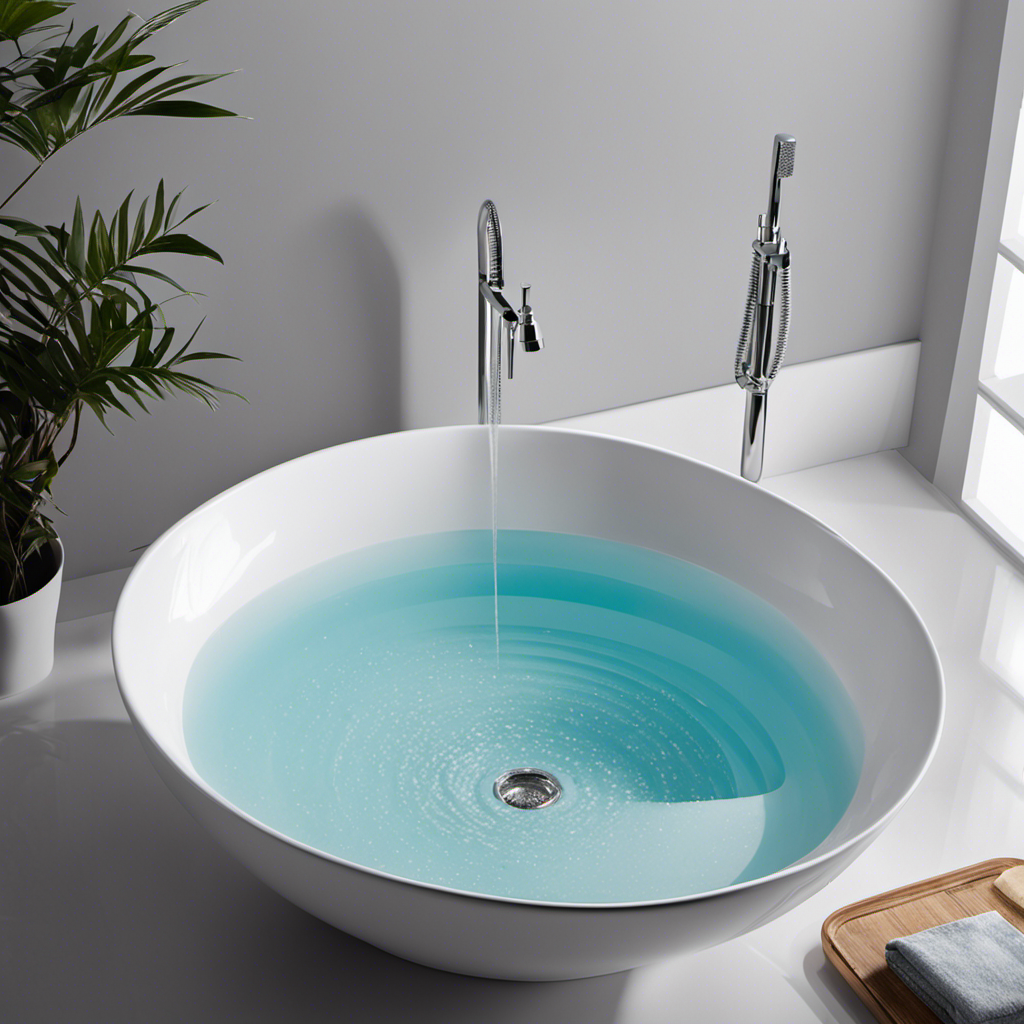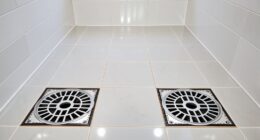Did you know that clogged bathtub drains are a common problem faced by many homeowners? If you’re tired of standing in ankle-deep water every time you shower, then you’ve come to the right place.
In this article, I’ll show you step-by-step how to effectively clean hair from your bathtub drain. With the right tools and a little know-how, you’ll be able to tackle this pesky issue and restore your drain’s efficiency in no time.
So let’s get started!
Key Takeaways
- Assess the severity of the clog by inspecting the drain with a flashlight.
- Use tweezers or a drain snake to remove visible hair from the drain surface.
- Consider using a drain cleaner or plunger for tightly packed hair clogs.
- Prevent future hair clogs by using drain covers or hair catchers and regularly maintaining them.
Assess the Extent of the Hair Clog
Now, you need to take a look at the drain and figure out just how much hair is causing the clog. Assessing the severity of the hair clog is crucial in determining the appropriate removal method.
Start by removing the drain cover or stopper to gain access to the clogged area. Use a flashlight to inspect the drain and see how much hair is present. If it’s just a small amount, you may be able to remove it with a pair of tweezers or a drain snake.
However, if the clog is more severe and the hair is tightly packed, you may need to use a drain cleaner or a plunger to dislodge it. Remember to always wear gloves and take necessary precautions when dealing with drain clogs to avoid any injuries.
Gather the Necessary Tools and Supplies
First, you’ll need to gather all the tools and supplies you’ll need for the job. Cleaning a bathtub drain clogged with hair can be a messy and frustrating task, but with the right tools and techniques, it can be done efficiently. Here is a list of the essential tools and supplies you will need:
| Tools | Supplies |
|---|---|
| Drain snake | Baking soda |
| Rubber gloves | Vinegar |
| Screwdriver | Hot water |
| Bucket | Cleaning brush |
| Plunger | Drain cleaner |
Having these tools and supplies ready will make the process much easier. Additionally, it is important to learn techniques for preventing hair clogs in the bathtub drain. Regularly using a drain cover or strainer can help catch hair before it goes down the drain. You can also periodically pour baking soda and vinegar down the drain to prevent buildup. By taking these preventive measures and having the right tools on hand, you can keep your bathtub drain clean and clog-free.
Remove Visible Hair From the Drain Surface
To begin, you’ll want to grab a pair of rubber gloves to protect your hands.
When it comes to removing visible hair from the drain surface, there are a few effective techniques you can try.
One option is to use a pair of tweezers or needle-nose pliers to carefully pull out the hair strands. Be sure to work slowly and gently to avoid damaging the drain.
Another method is to create a natural drain cleaner using ingredients you likely already have at home. Mix equal parts baking soda and vinegar and pour it down the drain. Let it sit for about 30 minutes, then flush with hot water. This will help dissolve any hair or debris that may be causing the clog.
Now, let’s move on to the next step: using a drain snake or auger to clear the clog.
Use a Drain Snake or Auger to Clear the Clog
One effective way to clear the clog is by using a drain snake or auger.
When it comes to clearing hair clogs in bathtub drains, manual methods like drain snakes or augers are often more effective than chemical cleaners. Chemical cleaners may not always dissolve the hair completely, leaving some residue behind and potentially causing more clogs in the future.
Using a drain snake or auger allows you to physically remove the hair from the drain, ensuring a thorough clearing of the clog.
To prevent hair clogs in the first place, there are a few tips you can follow. Installing a drain cover or hair catcher can help catch the hair before it goes down the drain. Regularly cleaning the drain cover or hair catcher is also important to prevent buildup. Additionally, brushing your hair before showering can help to minimize the amount of hair that goes down the drain.
Prevent Future Hair Clogs With Regular Maintenance
Regularly maintaining your drain by using a drain cover or hair catcher can help prevent future clogs. It is important to use drain covers because they act as a barrier, catching hair and preventing it from going down the drain. This simple step can save you from the hassle of dealing with a clogged drain later on.
In addition to using drain covers, there are also natural remedies that can help prevent hair clogs. For example, you can create a mixture of vinegar and baking soda and pour it down the drain once a month. This will help break down any buildup and keep your drain flowing smoothly.
Conclusion
In conclusion, cleaning hair from a bathtub drain can be a tedious but necessary task. By assessing the extent of the clog and gathering the right tools, such as a drain snake or auger, you can effectively remove the hair and prevent future clogs.
Regular maintenance is key to keeping your drain hair-free. So, don’t let your bathtub drain become a hairy nightmare, take the time to clean it regularly and enjoy a clog-free bathing experience.
Remember, a well-maintained drain is the key to a blissful soak.










